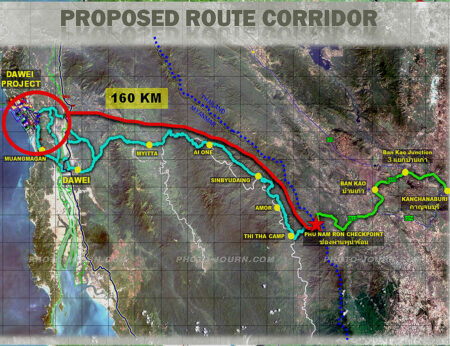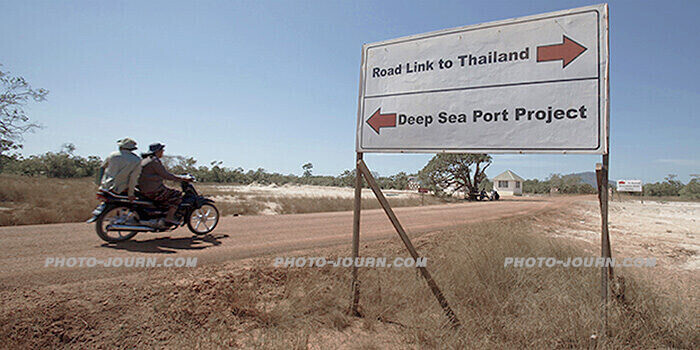After years of talk and a cost blow-out forecast last month of more than 62 per cent over the phase one original budget, the Thailand-Myanmar deep-sea port and special economic zone (SEZ) project is in suspended animation, with the Japanese Government steadfastly refusing to join the ambitious project.
According to Thailand’s Office of Transport and Traffic Policy and Planning (OTP) there are concerns regarding the return on investment the Dawei deep-sea project will generate due to discrepancies in project information, meaning the entire concept needs to be reviewed.
Coinciding with the announcement Thailand’s Transport Minister, Chadchat Sittipunt, said talks aimed at enticing the Japanese government to invest in the project had gone nowhere, with “Japan no closer to joining the project than it was when talks commenced last year”.
According to Mr Chadchat the Japanese government disagrees with a number of aspects of the Dawei deep-sea concept, including Thailand’s proposed port locations.
Inefficient wharf practices, impractical design

The original Dawei deep-sea port and special economic zone project sees the ports for container vessels in the same location as berthing for the SEZ, which Japan claims will lead to shipping traffic congestion and inefficient wharf practices.
Japanese officials have said the design is impractical and have said the two ports should be in different locations, much the same as Thailand’s industrial port is situated in Map Ta Phut, while the country’s container port is located in Laem Chabang.
Originally scheduled to occupy more than 2,04sq.km (about 79 square miles) and include a 33MW gas-fired and a 180MW combined cycle power plant and provide a link between the Indian and Pacific oceans, the project suffered a major setback last year when Myanmar’s Max Myanmar Group, a domestic partner in the Dawei deep-sea project, announced it was withdrawing its 25 per cent stake in Dawei Development Co Ltd.
A further blow to the project, which has been trumpeted in Thailand as providing exceptional logistics benefits and freight savings when complete, came last December when Myanmar’s President, Thein Sein, suggested to Thailand Prime Minister Yingluck Shinawatra that the project should be scaled back to 1,250sq.km (58 square miles).
At the same meeting the Myanmar President said he intended to invite a third country, most likely Japan, to participate in the Dawei deep-sea project.
The proposed Dawei deep-sea project is one of three proposed or under construction in Myanmar, with the first, the Japanese-Myanmar Thilawa Special Economic Zone and deep sea port 25km (15.5 miles) from Yangon expected to commence operation early this year.
The second, a 9,593sq.km (3,704.04 square mile) Kyauk Phyu Special Economic Zone and a deep -sea port and terminal for the gas and oil pipelines to China, together with an 800km (497 mile) railway and highway from Arakan State to Yunnan, a joint Myanmar-China collaboration.
Feature photo EPA
He has spent extensive periods of time working in Africa and throughout Southeast Asia, with stints in the Middle East, the USA, and England.
He has covered major world events including Operation Desert Shield/ Storm, the 1991 pillage in Zaire, the 1994 Rwanda genocide, the 1999 East Timor independence unrest, the 2004 Asian tsunami, and the 2009, 2010, and 2014 Bangkok political protests.
In 1995 he was a Walkley Award finalist, the highest awards in Australian journalism, for his coverage of the 1995 Zaire (now Democratic Republic of Congo) Ebola outbreak.
Most recently he was the Thailand editor/ managing editor of AEC News Today . Prior to that he was the deputy editor and Thailand and Greater Mekong Sub-region editor for The Establishment Post, predecessor of Asean Today.
In the mid-80s and early 90s he owned JLF Promotions, the largest above and below the line marketing and PR firm servicing the high-technology industry in Australia. It was sold in 1995.
Opinions and views expressed on this site are those of the author’s only. Read more at About me
Latest posts by John Le Fevre (see all)
- Kaavan’s great escape photo special (video & gallery) – November 30, 2020
- A real life fairy tale: Cambodia provides sanctuary to Kaavan, the world’s loneliest elephant (video & gallery) *updated – November 30, 2020
- Death for corruption and press freedom abused as Thailand continues Nth Korean-like slide – July 23, 2015
- Thailand’s young rice farmers boost income, slash costs with switch to organic, AWD method – May 29, 2015

